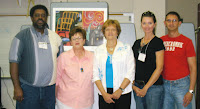
I have some suspicion that there are teachers out there who are afraid of using liquid tempera paint in the regular classroom. Well, it is paint and kids and paint and desks and carpet usually don't mix well. I hope that I can give you some pointers and if you are a teacher who uses tempera paints often and have other ideas- please share!
One- I save newspapers to cover desks and tables. I ask parents to send a large shirt as a smock. I also keep several for those who don't bring one. Wearing them backwards is the best, if you have a helper with the little dudes or if they can button someone else's. I keep the paint in plastic bowls like tupperware so it has a lid. It will last a good while in these if you keep it closed. Each color has its own brush. No rinsing brushes allowed. If you can get old cafeteria trays, they are the best for holding the paint bowls.
Have them put their name in pencil on the back before painting!
Step one: tell students to paint the lightest colors first such as yellow or if you have premixed lighter tints like pink or light blue. The darker colors go last. I sometimes have the colors by warm (red, orange, and brown) or cools and then switch the trays so part of the group is painting with warms and part cools. It just depends on the lesson. You may want them to learn to mix colors or tints and shades and in that case, you will need stryofoam or plastic plates for them to mix the paints. Remember: black is the last color to use. When two wet colors are next to each other they will run together so I try to demonstrate how to paint sections apart from each other before they start.
Step two: when the students have covered the paper, take the paint away! They tend to keep painting over places and creating "mud".
Step three: no one moves until the paint trays are collected and out of the way. Then, the brushes go into a bucket, I used a pickle bucket from Mickey Ds.
Step four: I collect the paintings to dry. Since tempera is water based, it will dry fairly quickly so as soon as I see the shine off the colors, I can stack them. I have used clothesline in the room to hang works, but found out that it violates fire code. So, I used clothes pins and pinned them to the blinds.
It is nice if you have construction paper to use as a back mat and glue the paintings down. Try to use the heaviest paper you can for the painting. Manilla paper works fine. So does the heavy construction paper. Watercolor paper is the best, pricey, if you plan to paint a lot. You might be able to split a ream of paper with another teacher.
There are so many subjects that can be painted with tempera. It makes a good paint for stamping too if you soak sponges.
My cleanup: have cheap babywipes for their hands. Unless they are covered in paint, the wipes will get it off without having to wash hands. Of course painting is nice right before they have a restroom break!
Have a colorfilled room this fall!
Durinda








